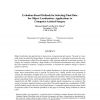Free Online Productivity Tools
i2Speak
i2Symbol
i2OCR
iTex2Img
iWeb2Print
iWeb2Shot
i2Type
iPdf2Split
iPdf2Merge
i2Bopomofo
i2Arabic
i2Style
i2Image
i2PDF
iLatex2Rtf
Sci2ools
APIN
1998
1998
Evolution-Based Methods for Selecting Point Data for Object Localization: Applications to Computer-Assisted Surgery
Object localization has applications in many areas of engineering and science. The goal is to spatially locate an arbitrarily-shaped object. In many applications, it is desirable to minimize the number of measurements collected for this purpose, while ensuring sufficient localization accuracy. In surgery, for example, collecting a large number of localization measurements may either extend the time required to perform a surgical procedure, or increase the radiation dosage to which a patient is exposed. Localization accuracy is a function of the spatial distribution of discrete measurements over an object when measurement noise is present. In [Simon et al., 1995a], metrics were presented to evaluate the information available from a set of discrete object measurements. In this study, new approaches to the discrete point data selection problem are described. These include hillclimbing, genetic algorithms (GAs), and Population-Based Incremental Learning (PBIL). Extensions of the standard...
| Added | 21 Dec 2010 |
| Updated | 21 Dec 2010 |
| Type | Journal |
| Year | 1998 |
| Where | APIN |
| Authors | Shumeet Baluja, David Simon |
Comments (0)

